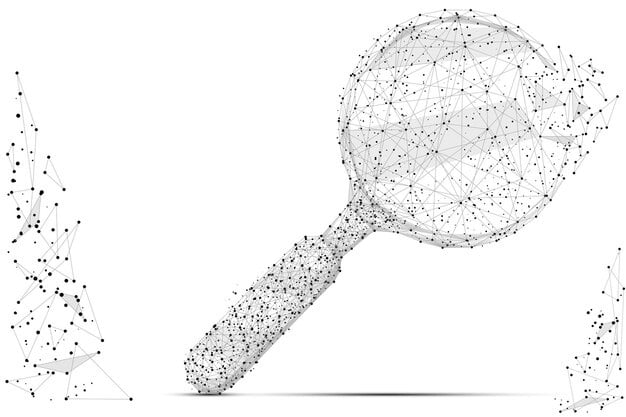Master Complex Movie Plots: Spoiler-Free Guide

This guide provides practical, spoiler-free strategies for understanding complex movie plots, focusing on analytical skills and thematic comprehension to enhance the viewing experience without revealing key story elements.
In an age where cinematic storytelling pushes boundaries, understanding intricate narratives has become both a challenge and a reward. Our guide to Navigating the Narrative Maze: A Spoiler-Free Guide to Understanding Complex Movie Plots offers a roadmap for viewers seeking to unlock deeper meaning without compromising the viewing experience. This exploration delves into techniques that empower you to grasp nuanced plots, appreciate thematic layers, and connect with stories on a richer level, all while meticulously avoiding any spoilers.
The Art of Active Viewing: Beyond Passive Consumption
Engaging with a film’s narrative goes beyond simply watching; it involves active participation. Complex movie plots often demand more from the audience, inviting them to piece together clues, interpret symbols, and anticipate developments. This section introduces the concept of active viewing as a fundamental skill for deciphering intricate cinematic works.
An active viewer approaches a film with an inquiring mind, paying attention to details that might appear insignificant at first glance. This involves noting character motivations, studying camera work, and observing shifts in tone. By consciously processing these elements, you begin to build a mental framework that helps connect disparate plot points.
Deconstructing Narrative Layers
Many complex films incorporate multiple narrative layers, ranging from character-driven arcs to overarching philosophical themes. Learning to identify these layers is crucial for comprehension. This process involves recognizing the immediate story events while simultaneously searching for deeper implications or underlying messages.
- Identifying the core conflict: What is the central struggle or question posed by the film?
- Recognizing thematic motifs: Are there recurring ideas or symbols that underscore the narrative?
- Tracing character development: How do characters evolve or remain stagnant, and what does this signify?
By breaking down a film into its constituent layers, viewers can systematically understand how different elements contribute to the overall narrative tapestry. This method helps prevent feelings of being overwhelmed by complexity.
Moreover, active viewing encourages patience. Some complex plots unfold gradually, withholding information until a pivotal moment. Resisting the urge to immediately understand everything at once allows the story to develop at its own pace, enhancing the eventual gratification of comprehension without spoilers.
Understanding Non-Linear Storytelling: A Different Kind of Path
One of the most common techniques employed in complex movie plots is non-linear storytelling. Instead of a straightforward chronological progression, these narratives jump between different timelines, use flashbacks, or explore parallel realities. This approach can be disorienting but also highly rewarding if understood.
Filmmakers use non-linear structures to create suspense, reveal character depth gradually, or explore cause-and-effect relationships from unique perspectives. The key to navigating these plots is to track the various timelines or narrative threads. While it may seem daunting, a systematic approach can transform confusion into clarity.
Mapping Temporal Jumps
When a film shifts between different time periods, it often provides subtle cues to help the audience orient themselves. These cues can be visual (changes in set design, costumes, or character appearance), auditory (distinct musical themes for different eras), or contextual (dialogue that references past or future events).
- Look for visual cues: Architecture, technology, and fashion can signal a change in time.
- Listen for auditory signals: Music or specific sound effects might be associated with particular timelines.
- Pay attention to character age or memory: References to earlier events often anchor a timeline.
Developing a mental map of where each scene fits chronologically, even if not explicitly stated, can significantly aid comprehension. It’s like assembling a puzzle where each piece, though introduced out of order, eventually finds its rightful place.
Furthermore, non-linear narratives often reveal information incrementally, building suspense and encouraging re-evaluation of previously seen events. Embracing this unfolding rather than resisting it is crucial. The beauty lies in the journey of discovery, not just the final destination.
The Role of Unreliable Narrators and Ambiguity
Many complex films derive their intrigue from ambiguity and the use of unreliable narrators. An unreliable narrator is a character whose credibility is questionable, leading the audience to doubt the veracity of the story being told. This technique creates a layer of uncertainty, challenging viewers to discern truth from deception.
Ambiguity, on the other hand, leaves certain elements of the plot open to interpretation. This can involve unresolved endings, unexplained phenomena, or morally gray characters. Both elements are powerful tools that stimulate thought and discussion, moving the film beyond pure entertainment into intellectual engagement.
Discerning Truth in Shades of Gray
When confronted with an unreliable narrator, the audience must become detectives, analyzing the narrator’s motives, biases, and inconsistencies. This involves scrutinizing their actions versus their words and observing how other characters react to them. The disconnect between what is presented and what might be true forms the core of the interpretive challenge.
- Question the narrator’s perspective: Why might this character be telling the story in a particular way?
- Cross-reference information: Do other characters or objective elements of the film contradict the narrator?
- Analyze gaps and omissions: What information is conspicuously missing, and why?
Embracing ambiguity means accepting that not every question will have a definitive answer. Some films are designed to provoke thought rather than provide neat resolutions. This open-endedness can be frustrating for some viewers but is deeply satisfying for others who enjoy intellectual puzzles.

Ultimately, the presence of unreliable narrators and ambiguity transforms film viewing into an interactive experience. It demands that the audience actively participate in constructing meaning, making their interpretation a vital part of the film’s artistic impact without relying on any spoilers.
Thematic Analysis: Unlocking Deeper Meaning
Beneath the surface of complex plots often lie profound themes, philosophical questions, or social commentaries. Thematic analysis involves identifying these underlying ideas and understanding how they are woven into the narrative fabric. This goes beyond plot points and delves into the film’s message and its broader implications.
Understanding themes enriches the viewing experience, allowing audiences to connect with the film on a more intellectual and emotional level. It provides context for character motivations, plot twists, and stylistic choices. A film that might seem confusing on a purely narrative level often becomes coherent when its thematic core is grasped.
Identifying Recurring Ideas and Symbols
Themes are typically conveyed through recurring symbols, leitmotifs, character archetypes, or specific narrative patterns. Paying attention to these repetitions and variations can reveal the filmmaker’s central message. For instance, a recurring image of a mirror might symbolize self-reflection or duality.
- Look for recurring objects or actions: Do certain elements appear multiple times and carry symbolic weight?
- Consider character archetypes: Do characters represent broader human experiences or societal roles?
- Analyze the film’s ending: Does the resolution (or lack thereof) reinforce a particular theme?
Connecting these dots allows viewers to move beyond simply following the story and begin to interpret its deeper significance. It’s about understanding the “why” behind the “what,” leading to a more profound appreciation of the cinematic art form.
Thematic analysis particularly shines in films that opt for metaphorical storytelling over literal exposition. By understanding the themes, even abstract narratives can become comprehensible and incredibly impactful, providing layers of interpretation for future viewings.
Patience and Re-Watching: The Power of Second Impressions
For truly complex movie plots, patience is not just a virtue but a necessity. It is highly unlikely that every nuance of an intricate narrative will be understood on a single viewing. Many critically acclaimed films are deliberately designed to reveal more layers with each subsequent watch, encouraging re-engagement.
Re-watching a film allows viewers to notice details previously missed, reinterpret scenes in light of new information, and appreciate the craftsmanship that went into constructing the narrative. It transforms the initial confusion into a gradual process of discovery, making the comprehension itself part of the enjoyable experience.
Strategies for Effective Re-Watching
Re-watching doesn’t have to be a passive repetition. Approach a second viewing with specific questions in mind, or focus on different aspects of the film. For instance, on a first watch, you might focus on the plot; on a second, you might concentrate on character development or symbolic imagery.
- Focus on specific elements: Pay attention to camera angles, lighting, or specific dialogue that seemed important.
- Take notes: Jot down questions or observations to revisit later.
- Watch with a friend: Discussing the film beforehand or afterwards can illuminate different perspectives.
Each re-watch builds upon the previous one, creating a richer, more complete understanding of the film. Spoilers become irrelevant when you are actively constructing meaning and uncovering new layers of artistic intent yourself.
The willingness to revisit a complex film is a testament to its enduring quality and the viewer’s commitment to truly understanding it. This process fosters a deeper appreciation for the artistry involved and can turn a challenging initial viewing into a highly rewarding cinematic journey that avoids prior knowledge of spoilers.
Discussion and External Resources: Expanding Your Perspective
While this guide emphasizes spoiler-free understanding, engaging in post-viewing discussions and consulting specific types of external resources can significantly enhance your comprehension of complex movie plots. The key is to do this thoughtfully, ensuring any external information is sought *after* your own initial attempts at interpretation and is carefully vetted to avoid accidental spoilers.
Discussion with fellow viewers allows for the exchange of ideas and interpretations, often highlighting aspects of the film you might have overlooked. Different perspectives can shed light on ambiguous scenes, character motivations, or thematic implications. These conversations become a collaborative puzzle-solving exercise.
Curated Resources for Deeper Insight
When seeking external insights, prioritize analyses that focus on structure, themes, and filmmaking techniques, rather than plot summaries or specific reveals. Academic essays, interviews with the director or writers (after the film’s release), and spoiler-free critical reviews can be invaluable.
- Look for thematic analyses: Articles that dissect the film’s underlying messages or symbolism.
- Seek interviews with creators: Directors or writers often discuss their intentions and narrative choices in abstract terms.
- Read spoiler-free critical reviews: These often analyze the film’s structure and artistic merit without giving away key plot points.

Online forums and communities can also be beneficial, provided they are explicit about their spoiler policies. Participating in discussions that tag or separate spoiler-heavy content ensures you maintain control over your viewing experience. Such resources, when used judiciously, serve to broaden your understanding and confirm or challenge your own hypotheses, adding another rich layer to the process of understanding complex cinema without spoiling the narrative.
By blending your individual analytical efforts with carefully chosen external resources and robust discussion, you equip yourself with a comprehensive toolkit for mastering even the most challenging cinematic narratives. This synergistic approach allows for a truly holistic and spoiler-free engagement with the art of film.
| Key Aspect | Brief Description |
|---|---|
| 🔍 Active Viewing | Engage deeply with details like hints and visual cues to build comprehension. |
| 🔄 Non-Linear Narratives | Track multiple timelines and story threads by recognizing temporal shifts. |
| 💡 Thematic Analysis | Identify recurring symbols and ideas to understand the film’s deeper messages. |
| 🔁 Re-Watching | Revisit films to catch missed details and deepen overall comprehension. |
Frequently Asked Questions About Understanding Movie Plots
▼
Begin by consciously noting subtle details: character expressions, recurring symbols, costume changes, or even specific camera angles. Pause occasionally to reflect on what you’ve seen and how it might connect to earlier scenes. This practice helps build a richer, more connected understanding of the film’s unfolding narrative without relying on external information.
▼
Focus on identifying clear markers (e.g., changes in character appearance, specific dialogue referencing time, distinct visual palettes). Mentally assign events to different timelines as they occur. Don’t worry about understanding everything immediately; often, the purpose of non-linear storytelling is to reveal information gradually, making past events take on new meaning.
▼
Unreliable narrators challenge viewers to question the presented reality. Pay close attention to inconsistencies in the narrator’s story, how other characters react to them, and any visual cues that contradict their version of events. This technique creates a puzzle, forcing you to actively deduce what is truly happening versus what is being told by a biased source.
▼
While not strictly necessary for every film, re-watching highly complex narratives often unlocks deeper layers of understanding. On a second viewing, stripped of the initial uncertainty, you can focus on subtle clues, thematic connections, and character nuances missed during the first watch. It enhances appreciation for the filmmaking craft and narrative depth.
▼
Before discussing, establish ground rules with your audience about avoiding specific plot points or twists. Focus discussions on themes, character development, artistic choices, or your personal interpretive theories. If encountering online resources, seek out ‘spoiler-free’ reviews or forums that clearly distinguish spoiler sections. The goal is to share interpretations of meaning without revealing key narrative surprises.
Cultivating Cinematic Literacy: A Final Word
Mastering the art of understanding complex movie plots is an ongoing journey, one that transforms passive viewing into an intellectually stimulating pursuit. By embracing active viewing, recognizing diverse narrative structures, and delving into thematic layers, audiences can unlock a richer appreciation for the intricate storytelling that defines contemporary cinema. The strategies outlined within this guide are not merely techniques for comprehension; they are invitations to engage more deeply with the narrative mazes these films present, fostering a profound connection that transcends simple entertainment. Ultimately, the joy comes from deciphering the puzzle yourself, reveling in the subtle revelations and intellectual challenges that complex plots offer, all while preserving the magic of discovery by remaining spoiler-free. This cultivated cinematic literacy ensures every film, no matter how convoluted, becomes a rewarding intellectual endeavor.





